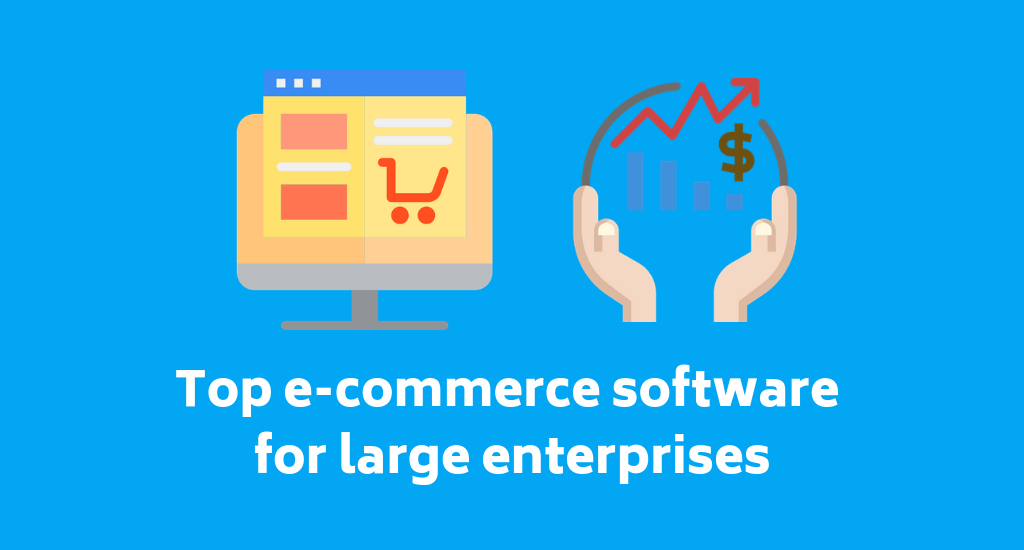Managing a store that makes $5 million per year can give you many headaches. That’s why investing in a top-notch eCommerce platform is fundamental. So, if you’re having a hard time deciding which system to pick, we’ve done the research for you. In this article, we will be discussing the pros and cons of the leading e-commerce systems for large businesses.
1. Magento Enterprise
Highly scalable, open-source, premium version of Magento is a worthwhile option for B2B and B2C businesses that need more customization and extra features. There are over 420,000 stores based on this eCommerce platform, including both Community and Enterprise edition.
The Good:
-
- Fully optimized for omnichannel
-
- Allows for deep customization with official extensions
-
- Provides customer-friendly shopping environment
-
- Offers a huge community of developers and integration partners
-
- 24/7 online support
-
- Enhanced analytics with Magento Business Intelligence
- Advanced SEO
The Bad:
-
- Heavy customisation makes it harder to maintain and scale
- Maintenance overheads due to upgrades and hosting
Costs:
The budget largely depends on the level of customization. Generally, the price of Magento Enterprise starts from $22,000. The license costs are revenue-based, which means that the more revenue you earn, the lower the license fee you’ll pay.
2. SAP Hybris
It’s an omnichannel eCommerce platform mainly aimed at big market players with multiple stores and established international presence. The e-commerce platform combines digital and physical sales smoothly. Live websites based on SAP Hybris count up to almost 12,000.
The Good:
-
- Offers a variety of customization and integration options
-
- Enables creating marketing campaigns without IT help
-
- Perfect for multiple-channel experience: desktop, mobile and brick and mortar
-
- Offers multi-language, multi-currency, and multi-website features
- Comes with advanced SEO features
The Bad:
-
- Costly customizations, upgrades, and third-party integrations
-
- Analytics and reporting underperform
- Extra charges for support and slow response time
Costs:
The licensing fee depends on the number of users, revenue, implemented features, etc. Compared to Magento Enterprise, the costs are significantly higher, but the company doesn’t reveal its pricing. You can contact them and ask for a quote.
3. Oracle ATG Web Commerce
Perfect eCommerce platform for all large retailers who seek international presence. 37% of companies using Oracle are big players with more than 1000 employees and $100M in revenue. The bulk of Oracle ATG clients come from computer software, retail, and IT industries.
The Good:
-
- A variety of customization and integration options available
-
- Guarantees omnichannel experience
-
- Template for a quick rollout of a new store
-
- One server caters for multiple stores
-
- It doesn’t slow because of heavy loads
-
- Offers advanced customer segmentation
- Personalised and data-driven customer experience
The Bad:
-
- Time-consuming customisation and development
- Customization restrictions
Costs:
Oracle licensing costs is $500,000. More customization will incur higher expenses.
4. IBM WebSphere Commerce
This eCommerce platform can be on the shortlist for high-volume merchants with multiple stores. According to Gartner, over 60% of IBM Websphere clients achieve $100 million in revenue.
The Good:
-
- Offers a range of customisation and integration options
-
- Encourages multi-channel sales
-
- Numerous integration partners
- Powerful marketing and promotion features
The Bad:
-
- Dropping value of IBM shares on the stock market
-
- Time-consuming customisation and development
- Requires experienced team of Java developers
Costs:
Pricing depends on the deployment mode and product edition. To get the exact price, consult their representatives.
5. Salesforce Commerce Cloud
This eCommerce platform is a cloud-based SaaS (Software as a Service) suited for enterprise-level retailers within the B2C segment, mainly from the fashion and lifestyle industries. It also provides excellent omnichannel experience for customers.
The Good:
-
- Seamless upgrades with no technical intervention
-
- Features that simplify buying and return process
-
- Well-performing marketing and analytics tools
-
- No need to worry about server maintenance
-
- Strong personalisation and product features
- Positive customer experience
The Bad:
-
- Not the best option for high-volume, low-margin sellers
-
- Limited customization and development options (SaaS)
- Requires the team of experienced developers
Costs:
Fees correlate with the sales volume declared by the merchant. For example, merchants with annual sales ranging from $20 million to $500 million could expect fees starting from $200,000. Development costs fall into $250,000 – 600,000 range.
Implementation time
It usually hovers around 12 months, with Magento allowing for slightly quicker implementation. Be aware that the time period depends on the scale of the project, business requirements, number of professionals involved, and their level of skill.
Final thoughts
There’s no one-size-fits-all software that will suit your business needs. Each platform has its strengths and weaknesses, therefore, to choose the best one, weigh down all the pros and cons to make a calculated decision. And keep in mind that all e-commerce platforms from the premium segment are hardly ever a one-time expense. On the contrary, they often require constant development and improvement.
CodesWholesale services
No matter which eCommerce platform you use, you can rely on our Dev Team to integrate your store smoothly with all the CodesWholesale services. API is a custom and open-source solution that allows you to cherry pick features that you’d like to implement and use in your store. It’s up to you to decide – you can either get only the essential endpoints for order automation or get the full package and unravel the full potential of CodesWholeale services.
Click here to go to CodesWholesale API docs.
If you’d like us to assist you in writing your implementation of CodesWholesale services, don’t hesitate to contact us!
About the author

- Berry
- E-commerce owner and blogger. A trained accountant and an avid gamer. Healthy food aficionado.
Latest entries
 Article2018.09.27The Pros and Cons of Order Fulfillment
Article2018.09.27The Pros and Cons of Order Fulfillment Article2018.09.27The Good and the Bad of eCommerce Platforms for Large Enterprises
Article2018.09.27The Good and the Bad of eCommerce Platforms for Large Enterprises Article2018.09.24How Wholesale Directories Like Worldwide Brands Can Empower Your Retail Business
Article2018.09.24How Wholesale Directories Like Worldwide Brands Can Empower Your Retail Business Article2018.09.24eCommerce Software for Large Enterprises: How to Choose It in 8 Steps
Article2018.09.24eCommerce Software for Large Enterprises: How to Choose It in 8 Steps


